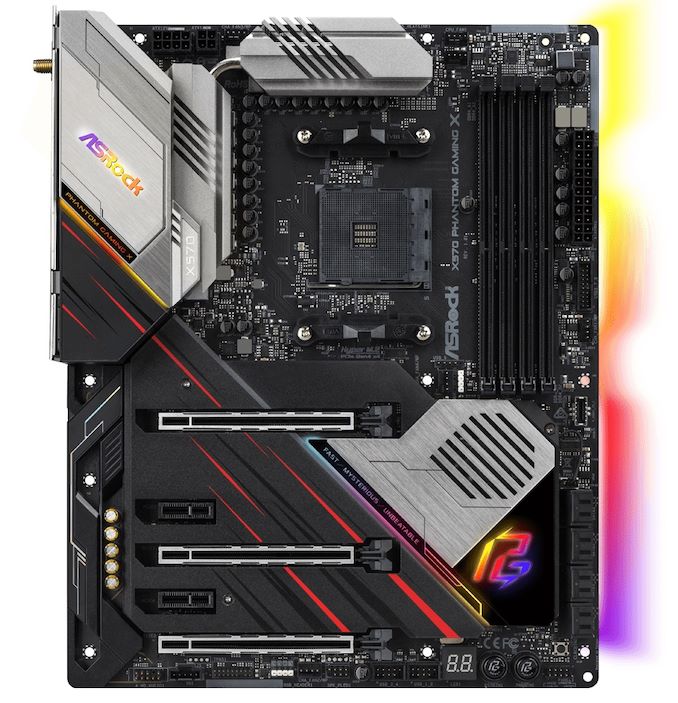The AMD X570 Motherboard Overview: Over 35+ Motherboards Analyzed
by Gavin Bonshor on July 9, 2019 8:00 AM ESTASRock X570 Phantom Gaming X
Another of the most high-end options from ASRock is the X570 Phantom Gaming X. The ASRock X570 Phantom Gaming X is a red, silver, and black themed premium gaming-focused model with some notable inclusions common to the Phantom Gaming branding. The most notable inclusion is the Realtek RTL8125AG 2.5 G LAN which is aimed at arming gamers with networking options.
In between the three full-length PCIe 4.0 slots is two PCIe 4.0 x1 slots, with support for up to three-way AMD CrossFire, and two-way NVIDIA SLI multi-graphics card configurations. Memory support is also much improved for Ryzen 3000 with official support for up to DDR4-4666, with a total of four slots available for users; this model also supports up to 128 GB of system memory. ASRock's X570 Phantom Gaming X is also geared for enthusiasts with a 14-phase power delivery which uses an 8-pin, and 4-pin pairing of 12 V ATX CPU power inputs. On the rear is a steel PCB brace which adds support to the PCB, as well as extra weight. On the storage front, there are three PCIe 4.0 M.2 slots, eight SATA ports, and ASRock's U.2 kit which available separately is also supported.
On the rear panel is a single USB 3.1 G2 Type-A, one USB 3.1 G2 Type-C, and six USB 3.1 G1 Type-A ports. The onboard audio is driven by the Realtek ALC1220 HD audio codec and offers uses five 3.5 mm audio jacks, a single S/PDIF optical output, with software support for Creative's Sound Blaster Cinema 5 software The rear panel also includes a Realtek RTL8125AG 2.5 Gigabit Ethernet port with a secondary Intel Gigabit port for dual LAN. Also featured is an Intel AX200 802.11ax Wi-Fi wireless interface, a Realtek ALC1220 HD audio codec, a single HDMI 1.4 video output, a clear CMOS button and a BIOS Flashback button.
The ASRock X570 Phantom Gaming X isn't as high-end as some of the other its new models such as the X570 Aqua, or X570 Creator, but gamers will find plenty of useful features to sink their teeth into. The ASRock X570 Phantom Gaming X has an MSRP of $350 and represents its flagship gaming model; a Realtek 2.5 G NIC and an Intel AX200 Wi-Fi 6 wireless interface add extra cost, but the board does lack a lot on the USB G2 connectivity on the rear panel, which is a little disappointing given the mid-range price tag.












225 Comments
View All Comments
DigitalFreak - Tuesday, July 9, 2019 - link
I think the only advantage of using a 2000 series CPU with an X570 board will be PCIe 3.0/4.0 support. The X370/X470 only supported PCIe 2.0. In theory, the connection from the 2000 processor to the X570 chipset should run at PCIe 3.0 speeds.FreckledTrout - Tuesday, July 9, 2019 - link
The x370 chipset and x470 both supported PCIe 3.0 with either a 1xxx or 2xxx Ryzen CPU. If you are not running a 3xxx CPU in the x570 board there isn't any major feature that should cause one to want to upgrade.DigitalFreak - Tuesday, July 9, 2019 - link
@FreckledTrout - Yes and no. The interconnect between the CPU and the chipset is PCIe 3.0 on X370 / X470, but all the PCIe lanes that come off the chipset are 2.0. Running a 2000 series CPU in an X570 board would give you a PCIe 3.0 link between the CPU and the chipset, with either PCIe 3.0 or 4.0 lanes coming off the chipset (depends on if AMD drops everything to PCIe 3.0 with a 2000 series processor).extide - Tuesday, July 9, 2019 - link
It looks like they still allow the chipset lanes to be 4.0. So you'd have 3.0 link to cpu, but 4.0 from chipset to devices.Targon - Thursday, July 11, 2019 - link
Since you have at least one or two PCI Express slots that are connected to the CPU, not chipset, that almost becomes a non-issue. On my Asus ROG Crosshair VI Hero(X370), you have PCI Express 3.0 x16 for the first slot, or x8/x8. The third PCI Express x16 slot is a 2.0 I believe, which is still enough to get the job done for many devices. Even with the X570 board with a first or second generation Ryzen processor, the most you end up with is an extra 3.0 supporting slot. Note that many boards may have x16 slots, but they are x8 electrically, so you won't see the full bandwidth anyway in those slots.sorten - Tuesday, July 9, 2019 - link
Thanks Gavin! This is a great resource and is exactly what I needed to help build my new system.willis936 - Tuesday, July 9, 2019 - link
The return of the 40mm fan! Those are the most obnoxious components ever. No one has missed them in the past ten years.Kastriot - Tuesday, July 9, 2019 - link
Buy Asrock aqua and problem solved.FreckledTrout - Tuesday, July 9, 2019 - link
I'm waiting for the next iteration of board for this reason. I'm speculating the next round the chipset will be on 7nm.abufrejoval - Tuesday, July 9, 2019 - link
The genious about that chiplet design is that the chipset doesn't actually benefit nearly as much from the shrink, as pure logic or SLC caches: The monolithic guys pay the 7nm overhead (e.g. EUV) for I/O while the geometry of the transistors in the I/O area is mostly determined by the need to power long motherbord or even slot traces.So while waiting is never a bad idea when your need clearly isn't overwhelming you, waiting for that shrink could turn out rather long. These days I/O heave chips might never be done in smaller geometries, because of that and because packaging has matured.